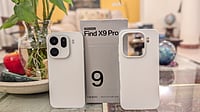When someone mentions a thin-and-light laptop that they are buying, I always get a bit of anxiety and then ask them a straightforward question. Are you someone who enjoys travelling frequently and not being tied to a desk at all times? If they answer yes to that question, then I try, with my utmost best, to steer them away from that laptop. I do so because I don’t want them to be disappointed by the poor battery life on these laptops. Having a thin chassis means a smaller battery, which in turn means poor screen-on-time.
It’s 2025, and thankfully, I no longer have to do that. That’s thanks to a new range of chips from Qualcomm, Intel and AMD; battery life anxiety is truly a thing of the past. I’ve had the pleasure of using the brand-new Zenbook A14 from Asus, and it’s truly a game-changer. Yes, I’ve achieved nowhere near the battery life quoted (up to 32 hours) by the company, even when trying to replicate their test results. Still, when you double the battery life of any previous-generation laptop, you feel like you’re lightyears ahead of everyone around you. Yes, I’m excluding Macbooks from this discussion. I know they’ve had excellent battery life for years, but they run on Mac OS, and we aren’t here to discuss which OS is better.
The question is: do you want a thin-and-light laptop running Windows 11 with exceptional battery life? The simplest answer is to look no further than the Asus Zenbook A14, which runs on Qualcomm’s Snapdragon X (there’s a variant with the X Elite) processor. Other laptops in 2025 also feature exceptional battery life, but none of them are in such a slim and premium package.
A few weeks before the launch in India, a friend and I were researching the laptops we planned to buy in 2025. We both needed a new laptop, and it was the right time to make the jump. One model that jumped out was the Zenbook A14. It features a sleek chassis, impressive battery life, a decent screen (although it lacks a touchscreen option), and the latest Snapdragon X processor from Qualcomm. What could go wrong, we said. For our regular workload, which includes light gaming and no video editing, this seemed like a dream machine.
Reality has hit now that I’ve used the laptop. Don’t get me wrong, the Zenbook A14 is still a beast of a laptop and one that I’ve recommended to my mother, but it isn’t for me. Let me explain.
There’s a lot to like about the Zenbook A14
The Zenbook A14 is the lightest Copilot Plus laptop I’ve tested so far. The thing that holds it back from being an instant recommendation is its processor. But we’ll get to that later. Let’s discuss how the company achieved the laptop’s thinness. Being light is all thanks to the Ceraluminium material (a compound of aluminium and ceramic) that the company introduced in the second half of 2024. The entire chassis is built from it. The design is premium, though the lid is not as smooth as some of the other laptops from the company. The Zenbook A14 has the sort of rigidity and durability you’d expect from much thicker laptops. Nonetheless, the design is premium, durable, not at all cheap or flimsy, but with a few bits of roughness. It weighs less than a kilogram and comes with a leather sleeve.
Thanks to Ceraluminium, the laptop is devoid of scratches, fingerprints, and smudges. You very rarely have to clean the laptop.
A laptop costing under Rs 1,00,000 that offers an OLED? Yep, that’s what you get here with the Zenbook A14. A 14-inch OLED display (1,920x1,200 resolution) that produces clear and crisp images. Yes, this sits one level below those 2.8K OLED displays you’ve seen on other laptops, but I’d take an OLED over an IPS LCD any day. The excellent contrast ratio and deep blacks are enough to convince me here. Yes, this isn’t the kind of display you’d use if you’re a photo/video editor, but for that, you’d anyway be having a desktop and a display with pinpoint colour accuracy. One last thing to note is that the bezels surrounding the OLED display are plastic. The only thing I’d be complaining about.
Have you ever heard the phrase, “all day all night long”? That sums up the battery life of the ZenBook A14. This laptop never gave up on me during my testing. At times, I forgot to even take the charger out of my bag. While I didn’t get the “up to 32 hours” that the company claimed, I easily got 14-15 hours of real-world usage. That’s easily double that of any laptop from the previous generation. It meant that I could have (with my medium workload) two days of battery life before having to plug it in.
The keyboard is okay. The keys do provide good tactile feedback and sufficient key travel, but there's nothing to write home about. It gets the job done, but somehow, for me, my fingers just didn’t roll smoothly from one key to another.
The touchpad is large and spacious, featuring smart gestures on its sides and top edges. I didn’t use these smart gestures often, but I know many who do. The only weakness is that the click response from the mechanical touchpad isn’t the same across the length and breadth of the touchpad.
The Zenbook A14 Isn’t Perfect
Yes, there is much to like about the Zenbook A14, and I’ve even recommended it to my mom (and a few other people), but I do have some gripes on the laptop.
Firstly, the dual speakers are of average quality. They are loud and rich but are ultimately lacking. They emit low, below-average-quality sound. They’ll suffice for basic YouTube videos, but if you’re watching a Christopher Nolan video, you’ll want to invest in some quality headphones or an external speaker. The problem is that during some scenes, the voice was off. It was either very low-sounding or muffled with the background noise. I put on The Fast and the Furious: Tokyo Drift, and this was clearly evident.
Second, the webcam, though 1080p, is, again, average. The image is sharp and suitable for video calls and conferences, but there is some oversaturation. Thankfully, the camera has an IR sensor and supports Windows Hello login. I say thankfully because this laptop doesn't have a fingerprint reader.
Last but not least, let’s talk about that underwhelming performance. I tested the Snapdragon X variant, and while it was no slouch, the laptop doesn’t suffice for video editing, nor is it suitable for gaming (even if we exclude the GPU from the equation). I’m not even going to discuss software compatibility, as it's futile. App compatibility has improved significantly since the Snapdragon X chips were first launched in the summer of 2024, but it still falls short of its ideal level.
The upside to all of this is that there is ample computing power available for regular users. Are you a journalist, a student, an influencer, or just someone who reads, writes and watches YouTube videos for research? Then, the ZenBook A14 will offer you plenty of computing power, along with a long battery life.
Verdict: The Best Thin-and-Light Laptop?
I wanted to give this laptop an easy 10/10 when I first came across it. Alas, that wasn’t to be the case. The Asus Zenbook A14 is on the right track and one of the best laptops available, but for me and many others, a little more computing power and perhaps a 2.8K OLED display would have been ideal.
Nonetheless, the Zenbook A14 is a super solid machine. The A14, at Rs 99,900, is a little pricier than I would have liked. Still, with an excellent OLED display, outstanding battery life, and a slim, premium profile, the ZenBook A14 is a winner. You just need to know if you’re the target audience or not. It’s a no-brainer for those who don’t need top-of-the-line performance.






























